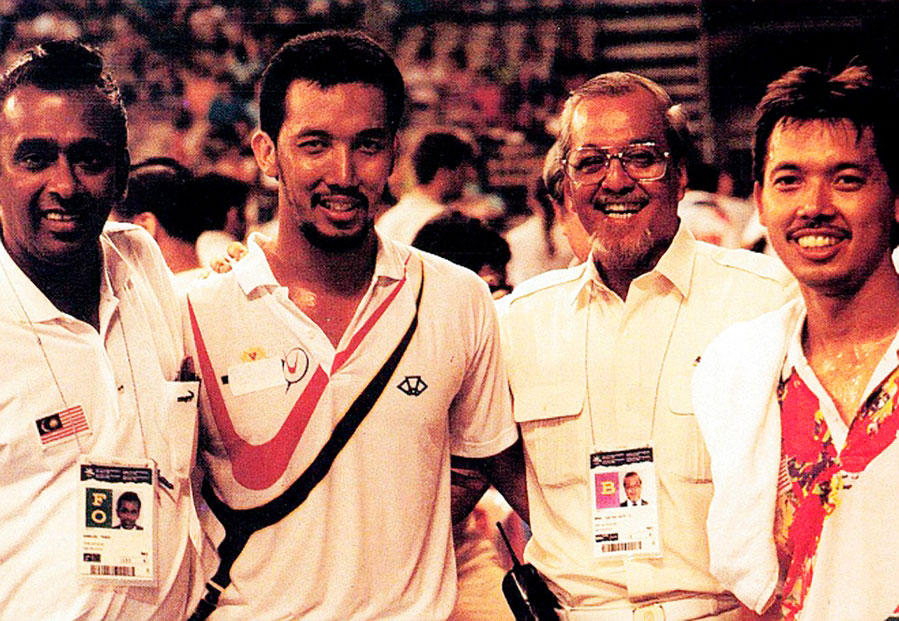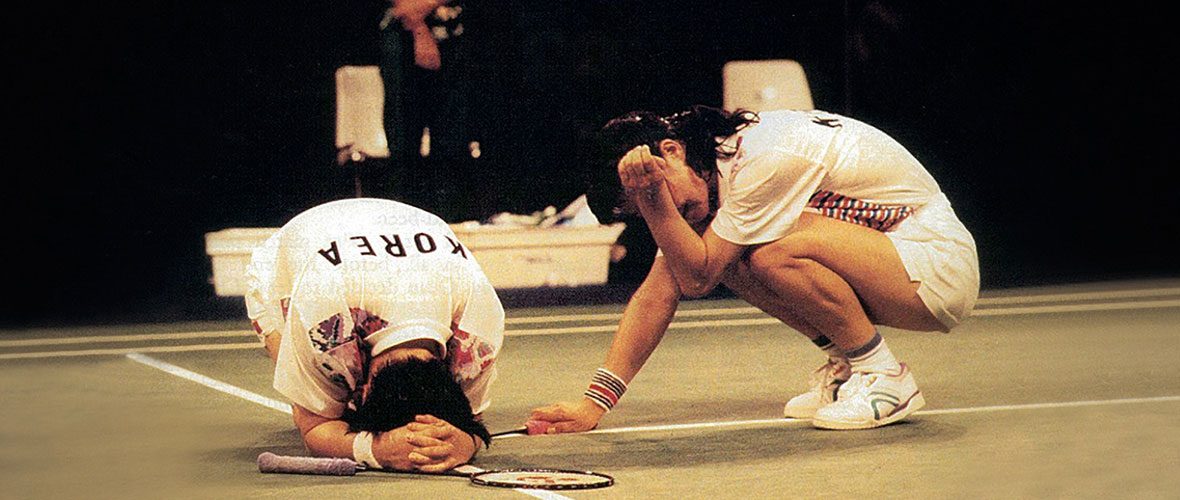Badminton – The Olympic Journey
The brief sketch given below outlines badminton’s attempts to become an Olympic sport; the challenges it faced; its debut as an Olympic sport in Barcelona 1992, and subsequent developments.
It was only in the mid-1960s that efforts were made to include badminton on the Olympic programme. When badminton was made a demonstration sport at the Munich Olympics in 1972, there was expectation all round that the Olympic stage was not too far off. The demonstration event was held on 4 September on two courts in a volleyball hall. Over 3000 spectators enjoyed the action on the single day it was played. The use of electronic scoreboards was a pointer of things to come.
Twenty-five players from eleven member associations participated; Indonesia’s Rudy Hartono and Japan’s Noriko Nakayama (née Takagi) won the singles titles, while Ade Chandra/Christian Hadinata (Indonesia – Men’s Doubles) and Derek Talbot/Gillian Gilks (England) won the Mixed Doubles. At this point, there was no Women’s Doubles.
However, from then on progress stalled as a sensitive political issue rose to the forefront. A parallel body called World Badminton Federation was formed on 24 February 1978; 13 Asian and six African associations became part of the breakaway group. The split of the IBF derailed its ambitions for badminton in the Olympics.
Efforts at rapprochement were made from both sides. On 26 May 1981 a ‘Deed of Unification’ was signed in Tokyo by IBF and WBF.
The reunification of the world body reignited its Olympic hopes. IOC President Juan Antonio Samaranch attended the IBF World Championships in 1983; the event produced some exhilarating displays of badminton and so impressed Samaranch that he was convinced badminton had a place in the Olympic programme.
The long-sought moment came at 5:45 pm on 5 June 1985 at the 90th IOC Session. Badminton was unanimously included for the 1992 Barcelona Olympics. As well as this, it would be played as an exhibition sport in the Seoul Olympic Games of 1988. The IOC flag was presented to the IBF at the World Championships in Calgary.
Seoul 1988 – Exhibition Sport
Thirty players from eight member associations made the trip to Seoul. The event was held in the Seoul National University Gymnasium (also a venue for table tennis) and was attended by a full house of 5000 people all through. The hosts had a good haul with three gold medals, courtesy of Hwang Hye Young (Women’s Singles), Kim Yun Ja/Chung So Young (Women’s Doubles) and Park Joo Bong/Chung Myung Hee (Mixed Doubles). China won the other two through Yang Yang (Men’s Singles) and Li Yongbo/Tian Bingyi (Men’s Doubles).

Barcelona 1992 – Debut as an Olympic sport
At 10 am on 28 July 1992 the long-cherished dream of millions of badminton fans finally materialised. Foo Kok Keong of Malaysia struck the first shuttlecock in Olympic badminton history, in the brand-new Pavella de la Mar Bella. Barcelona saw 178 players from 37 countries take part. The on-court action justified all the hard work that had gone into bringing badminton to the Olympics. An early-round Women’s Doubles match – between Gill Clark/Julie Bradbury (England) and Rosiana Tendean/Erma Sulistianingsih (Indonesia) was so compelling that TV viewership reportedly was 150 million.
Over the next few days, all four categories – Men’s Singles, Women’s Singles, Men’s Doubles and Women’s Doubles – produced matches of the highest class. The Indonesian off-court couple Allan Budi Kusuma and Susi Susanti won the singles medals proved a golden start for badminton, giving it a picture-perfect moment for decades to come. Indonesia’s wait for an Olympic gold medal had ended. Korea grabbed the other two gold medals, through Park Joo Bong/Kim Moon Soo (Men’s Doubles) and Hwang Hye Young/Chung So Young. Badminton had come of age in its very first Olympics. Sadly, there was no Mixed Doubles event in the Barcelona Olympics. Losing semi-finalists were given bronze medals.
Subsequent Developments
Over the course of the next six Olympics; Atlanta (1996), Sydney (2000), Athens (2004), Beijing (2008), London (2012) and Rio (2016) – badminton’s impact at the Olympics only got stronger, with viewership consistently breaking records. Meanwhile, in 2005, IBF was renamed BWF (Badminton World Federation).
From Atlanta 1996 onwards, Mixed Doubles was introduced – making badminton one of the few sports in which men and women shared the field of play. Another major change was the play-off for bronze. London 2012 saw the introduction of group competition followed by knock-out. This resulted in more match play for competitors and a significant increase in television production hours.
Following this, at Rio 2016 there were draws after the group stage took place to prevent players from anticipating their opponents in the knock-out stages.
The Tokyo Olympics, originally scheduled in 2020, had to be postponed by a year due to the COVID-19 pandemic. While there was widespread uncertainty in the run-up to the Games, Tokyo 2020 was delivered to perfection within a safety bubble. With detailed measures in place to prevent infection and outbreak, the Games provided the showcase for yet another stellar edition.
In the period following the Games, and with the pandemic fading, badminton would continue to grow from strength to strength.
FAQs
How do players qualify for Paris 2024?
Players qualify based on their performances during the 52-week qualifying period from 1 May 2023 to 28 April 2024. The World Ranking lists of 30 April 2024 will be used to allocate the athletes’ quota places in all five categories.
How many players can qualify in singles and in doubles?
The total number of players allocated to badminton cannot exceed 172. The exact number of singles and doubles players between Olympics varies as some players qualify in more than one category.
For Paris 2024, the initial number of athletes in each singles event is 38, while in each doubles event it is 32 (16 pairs).
How does the quota system work?
In singles, the BWF World Ranking lists as of 30 April 2024 will be used to allocate 35 individual quota places (per gender) to the highest ranked athletes, respecting the maximum quota allocation per NOC per event and including at least two athletes from each of the five BWF Continental Confederations (provided the player is ranked within 250).
In doubles, the Race to Paris Ranking lists of 30 April 2024 will be used to allocate quota places to the 16 highest ranked pairs in each category, respecting the maximum quota allocation per NOC per event. In each doubles category there shall be at least one pair from each of the five Continental Confederations, which shall be the highest ranked pair in the Race to Paris Ranking lists from the respective continent, provided the pair is ranked within the top 50.
Format
The competition consists of group stages followed by knock-out. Players/pairs from a particular NOC will not be drawn in the same group.
In singles, the number of groups will be based on the number of competitors, with a maximum of 16 groups. The number of seeds will correspond to the number of groups. There shall be up to 16 seeds in singles and four seeds in doubles. The seeds will be determined based on the BWF Ranking lists of 9 July 2024.
In singles, the top player from each group will qualify to the knock-out stage.
In doubles, the 16 pairs will be divided into four groups. The top two pairs from each group will qualify to the knock-out. A fresh draw (only for doubles) will be made for the knock-out stage (quarterfinals). Pairs from the same group will be separated in the knock-out stage.


















